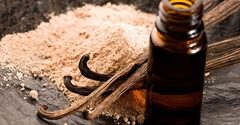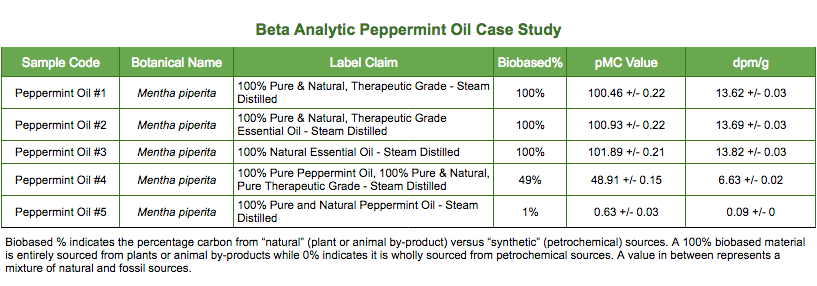The CEN Technical Report CEN/TR 17674 provides an overview of existing applications of isotope ratio analysis of carbon, hydrogen, oxygen and nitrogen that are relevant to the analysis of biobased feedstocks, products and production processes. This Technical Report validates the geographic origin and/or isotopic fingerprint of natural flavors, food products and feedstocks. It is based on the analysis of stable carbon isotopes (δ13C) using an Isotope Ratio Mass Spectrometer (IRMS) and is particularly suitable for authenticity controls of pure raw materials, providing the isotopic values of all organic elements contained in the samples. CEN/TR 17674, however, does not provide validation of whether a product is biobased (naturally sourced) or not.

The δ13C value (the ratio of isotopes 13C to 12C) is a function of the photosynthetic pathway of the plant material in question. Photosynthesis is the method by which plants turn water, light and carbon dioxide into energy for growth. The process of photosynthesis depends on the type of plant — C3 plant, C4 plant or Crassulacean Acid Metabolism (CAM) plant. Examples of C3 plants are cassava, soybean, and rice. C4 plants include sugarcane and maize/corn. Popular CAM plants include cacti, pineapple, vanilla and agave.
C3, C4 and CAM plants have different photosynthetic modes. C3 and C4 plants cycle carbon differently through their system, leading to fractionation of δ13C, producing distinct ranges of this isotope in their cells. As a result, C3 plants generally have a δ13C signature between -20‰ to -35‰, whereas C4 plants more commonly have a δ13C signature between -10‰ to -20‰.
While these two photosynthetic modes have some overlap in the ‰ of δ13C, it is still very useful to distinguish between the two to pinpoint the source of a biobased product. While δ13C can be useful in detecting plant types based on the photosynthetic pathway, it cannot confirm whether a material is biobased (naturally sourced) or not. It can only give an indication of whether the material in question is within the same δ13C signature bounds as the genuine plant in question.
Vanillin is the principal flavoring component in vanilla beans within an orchid, which operates using the CAM photosynthetic pathway; thus, any product which is marketed as pure genuine vanilla bean should have the δ13C of an orchid (CAM) plant. In natural vanilla beans from orchids, the δ13C is around -20‰, while alternatives which come from wood lignin (C3 plants; e.g. guaiaco) have δ13C ranges around -28‰ to -29‰.
Genuine vanilla flavoring is in high demand around the world, but the quantity of vanillin available is very limited. Thus, this type of flavoring is commonly adulterated. However, testing δ13C of vanilla may give an indication of whether it’s adulterated or not, but it cannot be conclusively determined without measuring the radiocarbon content (14C). Together, δ13C and 14C analyses could provide the basis for determining if it’s adulterated (14C) and potentially what the adulteration ingredient is (δ13C; e.g. guaiaco).
Carbon-14 analysis can provide evidence as to whether a product is made purely of modern plants and/or animals (naturally sourced) or if it has been adulterated with synthetic and/or petroleum-based materials. For example, Beta Analytic tested the authenticity of a series of Peppermint Oil and Garlic Oil samples which claimed to be all natural, demonstrating that only a small subset of the samples were actually 100% naturally sourced. Such testing can be undertaken using 14C analysis through the ASTM D6866 or ISO 16620-2 international standards.

References:
Reiffarth, D.G., Petticrew, E.L., Owens, P.N. and Lobb, D.A., 2016. Sources of variability in fatty acid (FA) biomarkers in the application of compound-specific stable isotopes (CSSIs) to soil and sediment fingerprinting and tracing: a review. Science of the Total Environment, 565, pp.8-27.
Hoefs, J., 2010. Geochemical fingerprints: a critical appraisal. European Journal of Mineralogy, 22(1), pp.3-15.
Basu, S., Agrawal, S., Sanyal, P., Mahato, P., Kumar, S. and Sarkar, A., 2015. Carbon isotopic ratios of modern C3–C4 plants from the Gangetic Plain, India and its implications to paleovegetational reconstruction. Palaeogeography, Palaeoclimatology, Palaeoecology, 440, pp.22-32.
Geißler, K., Greule, M., Schäfer, U., Hans, J., Geißler, T., Meier, L., Keppler, F. and Krammer, G., 2017. Vanilla authenticity control by DNA barcoding and isotope data aggregation. Flavour and Fragrance Journal, 32(4), pp.228-237.
Chartrand, M.M., Meija, J., Hélie, J.F., Middlestead, P., Ramalingam, M., Aziz, A.A. and Mester, Z., 2022. Characterization of vanillin carbon isotope delta reference materials. Analytical and Bioanalytical Chemistry, 414(27), pp.7877-7883.
Greule, M., Tumino, L.D., Kronewald, T., Hener, U., Schleucher, J., Mosandl, A. and Keppler, F., 2010. Improved rapid authentication of vanillin using δ 13 C and δ 2 H values. European Food Research and Technology, 231, pp.933-941.
2020. The difference between C3 and C4 plants. University of Illinois Realizing Increased Photosynthetic Efficiency (RIPE) project
2022. “Bio-based products: Use of stable isotope ratios of Carbon, Hydrogen, Oxygen and Nitrogen as tools for verification of the origin of bio-based feedstock and characteristics of production processes: Overview of relevant existing applications.” European Committee for Standardization (CEN)
Miami-based Beta Analytic is not affiliated with the European Committee for Standardization (CEN).
The ISO 17025-accredited lab provides rapid, high-quality carbon-14 analysis of various food products, natural flavors, and beverages, among others. For inquiries on testing fees and turnaround time, please contact the lab using this form or call (+1) 305-662-7760.

You might also be interested in these articles:
– Verifying Natural Products: Is Carbon-14 Analysis Necessary?
– Turmeric Case Study: Verifying “Natural” Claims by Carbon-14 and HPLC Analyses
– FREE Webinar: Stewarding Responsible Growth by Protecting the Integrity of the Curcumin Category * Available on Demand *
Join our mailing list to receive news of upcoming webinars by Beta and its subsidiaries as well as other industry updates.
This entry was posted on Friday, August 18th, 2023 and is filed under Biobased Products, Flavor & Fragrance, Flavors Carbon-14 Analysis, Natural Product Testing .